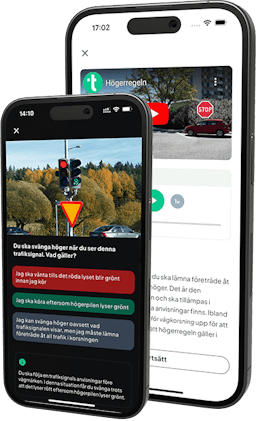Main Beam Headlights
You should use main beam headlights as often as possible in order to ensure optimal visibility. However, there are certain situations where it is not permitted to use main beam headlights.
When your main beam headlight cannot be used:
- Where there is adequate lighting: Adequate lighting means that no parts of the road are dark. In such cases, main beam headlights will not help you see any better as the road is already illuminated.

- When approaching oncoming traffic: When you approach oncoming vehicles, trams, trains or ships and there is a risk of dazzling the driver. You should continue to use your main beam headlights when approaching pedestrians, however.
- When driving behind another vehicle: If you drive so close behind the vehicle in front that there is a risk of dazzling the driver through their rear-view mirror.
Using main beam headlights will improve visibility in most cases, but there are some exceptions. Light can be reflected in thick fog or flurries of snow, which can reduce the visibility distance of main beam headlights compared with dipped headlights.
Dipped Headlights
You must always have the headlights on when you are driving. Most of the time, you will be driving with dipped headlights and parking lights combined.
Which lights can be combined with dipped headlights?
Not permitted
- Fog lights combined with dipped headlights
- Daytime running lights combined with dipped headlights
- Auxiliary high beam lights combined with dipped headlights
Permitted
- Parking lights combined with dipped headlights.
Daytime Running Lights
Daytime running lights can be used instead of dipped headlights when driving during the day in good visibility conditions. Daytime running lights cannot be used when driving in poor visibility conditions; e.g. at dusk, dawn, in rain, fog or similar. Daytime running lights may not be combined with fog lights.
Auxiliary High Beam Lights
For even more light, auxiliary high beam lights can be mounted onto the car. Auxiliary high beam lights should not be combined with dipped headlights; they should be used in situations where main beam headlights are permitted. Different types of auxiliary lights:
- Spotlights: Cast more light up ahead so that you get a longer depth of visibility.
- Cornering lights: Spread the light ahead, giving you a wider beam.

Fog Lights
Fog lights can be used instead of dipped headlights when driving during the day. They can also be used in the dark, but only in heavy rain or fog.
Parking Lights
You should have your parking lights on when your car is stationary in the dark, at dusk or at dawn and when the road lighting is poor. Exception: Two-wheel vehicles without a sidecar do not need to have parking lights on in this situation.
Tail Lights/Tail Lamps
Tail lights are used at the same time as main beam headlights, dipped headlights and parking lights. Tail lights consist of two red lamps which are placed at the rear of the car.
Brake Lights
When you depress the brake pedal, the brake lights come on. The brake lights are red and are placed at the rear of the car, together with the tail lights and indicators. Certain cars also have brake lights in the rear window.

Brake lights let vehicles behind you know that you are braking. To make sure that you warn other drivers in good time, you can begin by braking lightly before braking more strongly. This means that the brake lights will come on in good time, before you start braking properly.
Rear Fog Lights
A rear fog lights strengthens lighting at the rear so that vehicles behind can see you when visibility is reduced, e.g. during heavy snowfall or fog. You can see on the dashboard when the rear fog lights are on.
The rear fog lights emit a very bright light that can dazzle drivers behind you. You should therefore switch off your rear fog lights as soon as the driver behind has spotted you.
Reversing Lights
Reversing lights are lamps with white light which are placed at the rear of the car. The reversing lights will come on when you engage the reverse gear.
Indicators
Indicators have an amber, flashing light.
Indicators should be used in these situations
- When you are going to turn on the road
- When you are going to turn at a junction
- When starting from the roadside
- When changing lanes or otherwise moving to the side
Hazard Warning Lights
You can activate the hazard warning lights with a button on the dashboard, which is usually marked with a red triangle. When you do this, all four lights will flash at the same time.

You should use the warning hazard lights when you need to warn other drivers about an emergency situation, such as an emergency stop or an accident. It is not necessary to use hazard warning lights when being towed, but it is allowed to do so.
Rear Registration Plate Lamp
The plate lamp sits directly above the registration plate to illuminate it. It is illuminated when main beam headlights, dipped headlights or parking lights are on.


